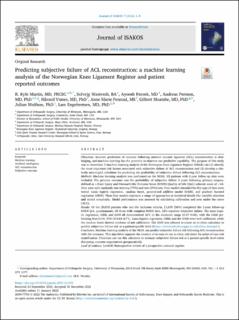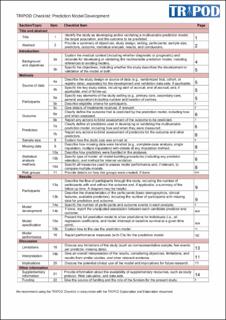| dc.description.abstract | Objectives: Accurate prediction of outcome following anterior cruciate ligament (ACL) reconstruction is challenging, and machine learning has the potential to improve our predictive capability. The purpose of this study was to determine if machine learning analysis of the Norwegian Knee Ligament Register (NKLR) can (1) identify the most important risk factors associated with subjective failure of ACL reconstruction and (2) develop a clinically meaningful calculator for predicting the probability of subjective failure following ACL reconstruction.
Methods: Machine learning analysis was performed on the NKLR. All patients with 2-year follow-up data were included. The primary outcome was the probability of subjective failure 2 years following primary surgery, defined as a Knee Injury and Osteoarthritis Outcome Score (KOOS) Quality of Life (QoL) subscale score of <44. Data were split randomly into training (75%) and test (25%) sets. Four models intended for this type of data were tested: Lasso logistic regression, random forest, generalized additive model (GAM), and gradient boosted regression (GBM). These four models represent a range of approaches to statistical details like variable selection and model complexity. Model performance was assessed by calculating calibration and area under the curve (AUC).
Results: Of the 20,818 patients who met the inclusion criteria, 11,630 (56%) completed the 2-year follow-up KOOS QoL questionnaire. Of those with complete KOOS data, 22% reported subjective failure. The lasso logistic regression, GBM, and GAM all demonstrated AUC in the moderate range (0.67–0.68), with the GAM performing best (0.68; 95% CI 0.64–0.71). Lasso logistic regression, GBM, and the GAM were well-calibrated, while the random forest showed evidence of mis-calibration. The GAM was selected to create an in-clinic calculator to predict subjective failure risk at a patient-specific level (https://swastvedt.shinyapps.io/calculator_koosqol/).
Conclusion: Machine learning analysis of the NKLR can predict subjective failure risk following ACL reconstruction with fair accuracy. This algorithm supports the creation of an easy-to-use in-clinic calculator for point-of-care risk stratification. Clinicians can use this calculator to estimate subjective failure risk at a patient-specific level when discussing outcome expectations preoperatively.
Level of evidence: Level-III Retrospective review of a prospective national register. | en_US |

